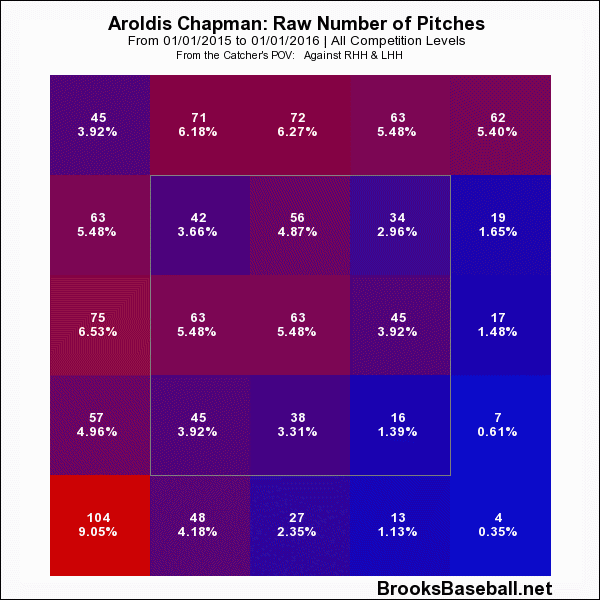It can be said a million ways with numbers, charts, and even flowery chains of adjectives, but put simply Aroldis Chapman throws baseballs harder than anyone else and it isn’t close.
Parents are consistently telling children that they are one-of-a-kind, and for most of us it’s absolute poppycock. However, if the Chapmans ever relayed this platitude to young Aroldis, they were spot on. The New York Yankees just acquired a pitcher who is utterly unique.
Not only is the 27-year-old different from all his peers, but he’s different in a way that has an important application on the baseball field. He’s not the only guy from Belarus, the guy who looks most like Mr. Potato Head or the best poet. Throwing the hardest fastballs in the game is awfully useful. Velocity isn’t everything, but at Chapman’s level it’s most things.
Given that the southpaw has a very particular skill set it, should be no surprise that the conventional wisdom of pitching may not always apply for him.
Often pitching coaches tell pitchers that they need to keep the ball down, and they tend to listen. Most pitchers throw significantly more of their offerings below the midpoint of the strike zone than above it. There is some sound logic to this. Low hard pitches are good bets to produce ground balls, and most secondary stuff is much more effective below the zone.
However, if you throw 100 mph things are a little different. The Brooks Baseball chart below shows where Chapman’s pitches went last year.
Although he did like to throw low-and-in to right-handers/low-and-away to lefties, by and large “keeping the ball down” is not something he seems to believe in. This falls in line with recent findings about Effective Velocity that shows that fastballs up, especially up-and-in, appear faster to the hitter than their radar gun readings would suggest.
If you’ve got the juice, pitching low in the zone is not a good idea, it only diminishes your best asset. Pitching up is the way to go. This is apparent in how hitters have fared against Chapman. The zone profile below shows his career batting average against by zone.
The only way opposing batters have gotten to former Reds closer is by hitting pitches low in the strike zone. A breakdown of his hits allowed by location shows the pattern continued in 2015.
| Location | Lower-Third and Below | Middle | Upper Third and Above |
|---|---|---|---|
| Hits Allowed | 21 | 15 | 7 |
| Percentage of Total Hits | 49.9% | 34.9% | 16.2% |
| Batting Average | .288 | .211 | .076 |
| Slugging Percentage | .356 | .267 | .076 |
These numbers are derived from a fairly small sample, but they give an idea of how Chapman’s effectiveness increases the higher he goes in the zone. It probably wouldn’t be wise for him to throw high fastballs every pitch as batters might catch on, but if there’s anyone who could pull it off, it would be him.
Chapman does one thing better than anyone else on earth and as a result he is best served working in a part of the zone where many pitchers are afraid to go. Traditional rules do not apply to him so he needs to live by his own.
When a pitcher struggles it’s not unusual to see a catcher make a slow downward signal with his hand and glove indicating he wants the ball kept low. Sometimes the backstop will even tap the ground to mean it should go in the dirt. With Chapman on the mound those signs can more or less be retired. Brian McCann may even need to come up with a new one for “keep the ball up”.
Until now, there hasn’t be much need for something like that, but McCann’s new closer isn’t like anyone else he’s caught. He’s not like anyone else there’s been.
Lead photo courtesy of David Kohl-USA TODAY Sports


